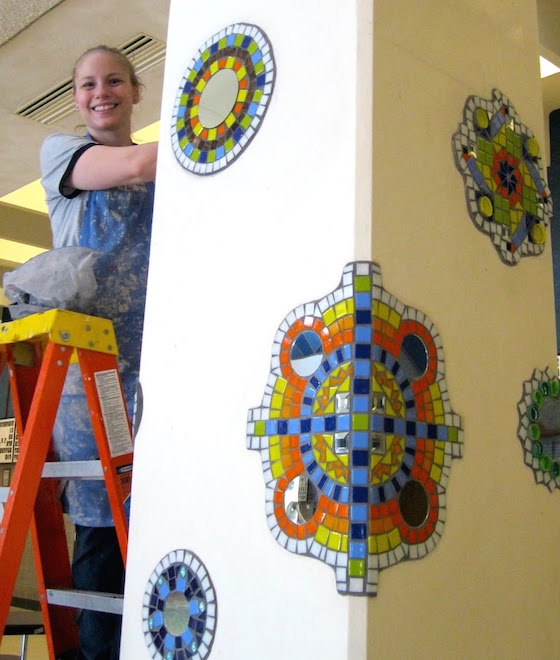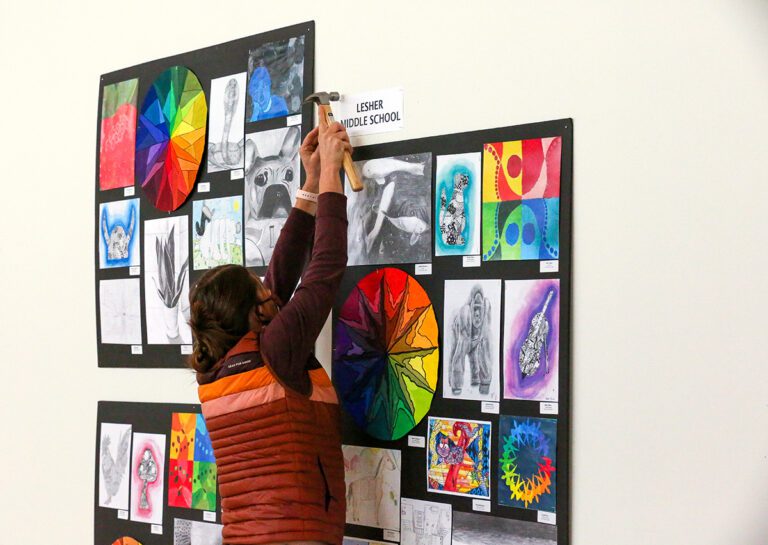Having an artist-in-residence can be an incredibly rewarding experience for students as well as participating staff members. Artwork created under the hand of a practicing artist can lead to a collaborative culture that fosters art appreciation and increased student confidence through art making.
There is always something magical about experiencing the creation of an artwork when hundreds of students take part. However, is it really possible to authentically involve the whole school in such a daunting process? The answer is that it is possible with careful planning and a willingness to be flexible.

Building a Collaborative Culture
A few years ago, my middle school invited a local mosaic artist to work with our students to create a collaborative found object relief sculpture for above our media center doors. We kicked off the project with grade-wide assemblies in which the artist explained her intentions and an outline of our process. Because this was a found object piece, we asked each student to bring an object from home to be included in the work: small toys, game pieces, little erasers, plastic beads, the list went on and on. I’ve never seen middle school kids so pumped to dig though their stuff at home to find their perfect additions to our artwork. Once we had the majority of the “junk” at school, the artist had small groups of kids push their objects into pre-made letter bases covered in black caulk. Although students were not intensively involved in creating artwork, our goal of promoting a collaborative environment through the creation of artwork was realized.

Strengthening Student Confidence
More recently, the mosaic artist was brought back with local grant funds to create a second installation for our district. This time, the project was to be a series of tile mosaic mandalas, created by as many of the district’s students as possible without sacrificing the quality of the art. After much brainstorming, the district art teachers agreed that we would each select 15-20 students to work closely alongside the artist to cut tile, lay out and glue patterns. This plan, however, was only going to involve about 5% of our student population. We asked ourselves how we could involve more students without making the participation feel forced or cumbersome to organize. We decided on using the artist’s vision of the work as project inspiration within our own classrooms.

For my students, this included creating CD and paper mandala designs. Not only was I able to involve all of my students in art making related to the larger project, but the students’ work provided jumping off points for the designs of the tile mandalas. When students were told that their individual works might be considered as blueprints for the permanent installation, the engagement increased and, in return, confidence in art making blossomed.

This year, our focus is to create a middle school-wide STEAM collaborative artwork. Working with the technology and science departments, our goal is to create an oversized periodic table of elements made from various materials. Students were involved in all parts of the process, from selecting materials, to designing the elements in Illustrator, to running the laser engraver and more. We plan to assemble each element into the oversized relief sculpture later this spring. Although we did not bring in an outside artist to organize this work, the effects are essentially the same. Students participate firsthand in a collaborative work that increases connections through art while deepening their appreciation for long-term projects.

How have you seen increased student connections and confidence when working with an artist-in-residence or visiting artist?
Does anyone have any tips for finding great artists with which to work on these types of projects?
Magazine articles and podcasts are opinions of professional education contributors and do not necessarily represent the position of the Art of Education University (AOEU) or its academic offerings. Contributors use terms in the way they are most often talked about in the scope of their educational experiences.




